Sustainable Development and Saudi Vision 2030: Entrepreneurial Orientation of Students Toward E-Businesses and Proposed Model of “Virtual Business Incubator” for SEU
Abstract
This study aims to explore Saudi students’ entrepreneurial orientation (EO) toward e-businesses in the line of achieving the strategic objectives of Saudi Vision 2030. Saudi Vision 2030 (hereafter, Vision 2030) is a strategic framework to attain the sustainable development of Saudi Arabia. It was first announced by Crown Prince Mohammad bin Salman in April 2016. Authors have proposed a Saudi Vision Linkages Model to show the role and importance of university education (UE) and entrepreneurial culture in fulfilling the specific requirements of the Saudi labor market to attain the ultimate strategic objectives of Vision 2030. The authors also proposed a conceptual model of the study to depict the relationships of EO with their entrepreneurial intention toward online businesses (e-EI). The study used a multidimensional model of the EO where three subdimensions, namely risk-taking propensities (RTP), innovativeness (INV), and pro-activeness (P-ACT), are used. The conceptual model of the study also shows UE and gender (GEN) as moderating variables. The authors used convenience sampling to collect cross-sectional data and conducted an online survey among the students at Saudi Electronic University (SEU) using a 5-point Likert-type scale to collect the data through a questionnaire, observing a total of 17 items and 408 filled questionnaires were received. Authors proposed six hypotheses where four hypotheses build the direct relations, namely, RTP (H1), INV (H2), P-ACT (H3), and UE (H4) with e-EI and hypotheses H5 and H6 are further divided into the subhypotheses, respectively, in H5a, H5b, H5c and H6a, H6b, H6c to show the moderating effect of UE (H5) and GEN (H6). SmartPLS 4.0 software is used to apply structural equation modeling for the analysis of data. Reliability, composite validity, discriminant validity, and model-fit indices of the measurement model are assessed before running a bootstrapping to measure the significance and standardized β estimates of the paths of hypotheses (structural model analysis). After analyzing the results, in the suggestions section, the authors have suggested that the university build a university business incubator for the students to promote entrepreneurial activities on all the campuses with a head office in the Riyadh campus.
1. Introduction
This study aims to explore Saudi students’ entrepreneurial orientation (EO) toward e-businesses in the line of achieving the strategic objectives of Saudi Vision 2030.
Saudi Vision 2030 (hereafter, Vision 2030) is a strategic framework to attain the sustainable development of Saudi Arabia. It was first announced by Crown Prince Mohammad bin Salman in April 2016. It is an attempt to shift the dependency of Saudi’s economy from the oil sector to the nonoil sector and to improve the public sector facilities like education, health, tourism, and infrastructure [1].
Vision 2030 is designed based on its three themes, namely, ambitious nation, thriving economy, and vibrant society (Figure 1). Each theme has two overarching objectives. So, there are a total of six overarching objectives for Vision 2030 (Figure 1), which are segregated into 27 branch objectives. These 27 objectives are further cascaded into 96 strategic objectives to enable effective implementation through 11, different Vision Realization Programs (VRPs) (Table 1). Each VRP aligns its actions/activities via approved execution plans. These plans are led to the preapproved objectives bound to a 5 years timeline [2]. Vision 2030 has moved into another 5-year stage (i.e., 2021–2025), and all the VRPs have been reviewed, assessed, and realigned to match the needs of the Kingdom and to best achieve in the specified time under Vision 2030.
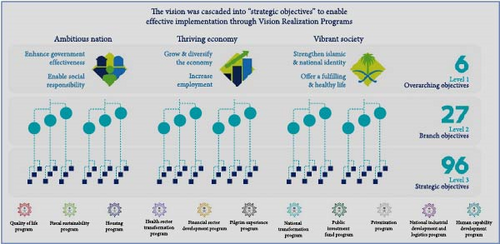
| Sr. no. | Vision Realization Program | Sr. no. | Vision Realization Program |
|---|---|---|---|
| 1 | Financial Sector Development Program | 7 | National Transformation Program |
| 2 | Fiscal Sustainability Program | 8 | The Pilgrim Experience Program |
| 3 | Health Sector Transformation Program | 9 | Privatization Program |
| 4 | Housing Program | 10 | Public Investment Fund Program |
| 5 | Human Capability Development Program | 11 | Quality of Life Program |
| 6 | National Industrial Development and Logistics Program |
- Source: Prepared by authors, information extracted from https://www.vision2030.gov.sa/.
One of the main targets of Vision 2030 is to modernize and diversify Saudi’s economy to further reduce the unemployment rate. Vision 2030 aims to reduce unemployment from 12.9% to 7%, and increase the contribution of the small and medium enterprises sector up to 35% of GDP by 2030. It also aims to generate six million additional jobs by the end of 2030 [3].
For achieving the objectives of Vision 2030, government has decided to reform the education sector and nurture the entrepreneurial culture and innovation among the students, and it has pumped huge resources into the education sector, especially in the universities for this reform.
The government is also attempting to increase the share of the digital economy minimum up to 19.6% of the GDP by 2030.
Practical Gaps. The authors found a gap between the strategic objectives of Saudi Vision and the execution plan to achieve them and, from there, the idea to extend this study was picked up. To bridge this gap, the authors proposed a linkage model (Figure 2). This model explores the linkages among Vision 2030, university education (UE), labor market, and entrepreneurial culture. This model explains the cyclical steps that are required to achieve the objectives of Vision 2030 and the role of entrepreneurial activities and UE to make Vision 2030, a success.
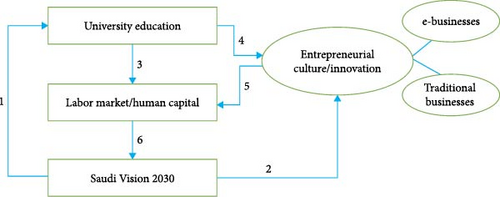
1.1. Saudi Vision Linkage Model
Authors have proposed this linkage model (Figure 2) to discover the linkages among Vision 2030, UE, labor market, and entrepreneurial culture, and this model is explained in the following steps.
1.1.1. Steps 1 and 4
Vision 2030 has set many strategic objectives under its various programs to improve UE under the Human Capability Development Program (HCDP), they are committed to improve the rankings of educational institutions and have a goal to bring at least six Saudi universities in the list of top 200 universities worldwide by 2025 (step 1). UE also promotes entrepreneurial education, culture, and ultimately entrepreneurial traits among the students (step 4).
1.1.2. Steps 2 and 4
“Nurture and support the innovation and entrepreneurship culture” is another strategic objective of Vision 2030. The vision committee has allocated the resources under the HCDP. This program aims to develop the country’s competitiveness at the global level by promoting entrepreneurial culture (step 2), especially among students via universities (step 4) and when it comes to nurturing the entrepreneurship culture, we are experiencing that existing entrepreneurs are forced to run their businesses online also along with their traditional format of business. Vision 2030 is also committed to increasing the contribution of the digital economy to 19.06% of the national GDP [4].
1.1.3. Steps 3, 5, and 6
Improved and transformed UE will help further in achieving many strategic objectives of Vision 2030 by providing the human capital as per the requirements of labor markets of all the sectors [5] (step 3). A well-nurtured entrepreneurial sector may also help the labor market by creating a number of jobs for the human capital available in that market (step 5). Only a well-developed labor market can fulfill all the requirements to achieve the underlying targets and objectives of Vision 2030 and can turn Vision 2030 into a reality (step 6).
The main research questions of the study are as follows: (1) how is the success of Vision 2030 linked with the entrepreneurial culture of the universities? and (2) how does UE affect the overall entrepreneurial intention of the students to start a business online? The main objectives of the study are to empirically analyze the EO of Saudi students toward e-businesses in line with achieving the objectives of Vision 2030 (Hypotheses H1–H4; refer to Figure 3), to assess the moderating role of UE toward the intention of students’ to start an e-business (Hypothesis H5; refer to Figure 3), and to propose a model of virtual business incubator to the university.
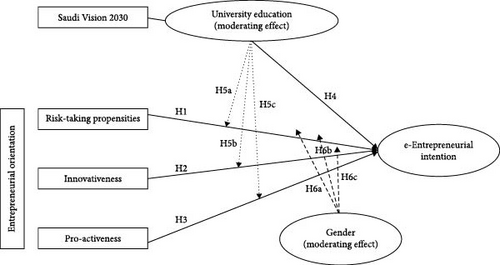
This study will add value to the existing literature in the public domain because many of its results are contradictory to the established facts it reveals that the innovativeness of the students does not have any significant effect on their e-entrepreneurial intention (e-EI) and the UE does not strengthen the relationship between the risk-taking propensities (RTP) of the students (UE × RTP ⟶ e-EI; H5a) and the relationship of their innovativeness (UE × INV ⟶ e-EI; H5b) with their e-EI to start an e-business.
This study will surely help the different stakeholders of the education sector (students, universities), labor market (budding entrepreneurs, employers), and decision-makers at Vision 2030 in one way or another if they consider the results, implications, and recommendations of the study. It will help universities in promoting entrepreneurial activities on campus, especially where the university is lacking.
1.2. Conceptual Model of the Study
After doing an extensive review of the available literature on the variables (picked from the linkages model), the authors chose UE in the light of Saudi Vision, individual entrepreneurial orientation (IEO) of Saudi students, students’ entrepreneurial intention toward e-businesses (e-EI), and gender of the students to extend the discussion under this study and decided to assess the EO of the Saudi students toward their intention (e-EI) to start an online business.
For this purpose, a conceptual model (Figure 3) is proposed by the authors to provide a framework for the study. The rest of the study is divided into the following sections: Section 2: review of literature and hypotheses development, Section 3: research methodology, Section 4: analysis and results, Section 5: discussion and conclusion, Section 6: implications and suggestions, and Section 7: limitations and scope of future researches.
2. Review of Literature and Hypotheses Development
2.1. E-Entrepreneurial Intention
Individual human behavior can mainly be defined through his/her intention. Human behaviors, like new venture establishment and buying medical insurance, are examples of their voluntary control. Much evidence is available to define that an individual’s behavior can be predicted the best by their intentions [6].
As far as entrepreneurial intention is concerned, it can be defined as the cognitive behavior through which an individual takes actions to create a new company/venture [7].
Entrepreneurship ideas indeed come into the mind of entrepreneurs with inspiration, but it is also true that it is the entrepreneurial intention of individuals that allows these ideas to manifest further in an individual’s mind [8]. So, if individuals set up their venture, that is not by their reflex but by their intention [9]. It is a planned behavior of taking a series of actions/steps/factors which transform an idea into a venture [10]. Therefore, intention is the first step of venture creation which also defines the form/direction of the venture [11].
Entrepreneurial intention comes from the prelaunch stage (Figure 4), and it is one of the most explored dimensions of the entrepreneurial process [12]. It is also proved that individual intention can be used as the best indicator to assess the future execution of planned behavior, it becomes more important if the action is very difficult to assess, not very common, or carries unexpected delays, as happens in the case of entrepreneurial intention to start a new venture. So, behavioral intention model can be used for research taking entrepreneurial intention into the consideration [13].

The EO of an individual revolves around her entrepreneurial intention [14]. Therefore, entrepreneurial intention is a must prerequisite to entrepreneurial action or behavior. Many authors have conducted studies on students’ entrepreneurial intention earlier also, but this study is unique because it develops a link between the EO of Saudi students, UE, and Saudi Vision 2030 [15].
2.2. University Education
UE in entrepreneurship and allied subjects may play a very important role in the development of a successful entrepreneurial venture [16]. Many studies showed that UE impacts entrepreneurial decisions very significantly [17]. UE helps young entrepreneurs in improving their self-efficacy, while the entrepreneurial skills and attitudes perceived by the individual student are also transformed by UE [18]. Various studies favor the role of education in developing entrepreneurial attitudes [19]. It is also stated that the level of the entrepreneurial intention of the students is derived from their UE Liñán and Fayolle [20]. Studies in past have also discussed the problems of UE [21]. A meta-analytic review [22] with a bigger sample size found that UE has a significant but very low correlation with entrepreneurial intention. Scholars also found that UE’s impact on entrepreneurial intention is very limited and short-term if the other facilities and supports are not available for budding entrepreneurs [23]. It is said that UE, alone, may not establish entrepreneurial sustainability [24].
- (H1)
UE of students significantly affects their e-EI
2.3. Entrepreneurial Orientation
Authors have the choice to choose the unidimensional or multidimensional measurement model of EO [25]. Based on the reviewed literature, it was decided to go with the multidimensional model of EO [26] because of its acceptance among the experts. It is the first multidimensional model of measurement of EO [27]. It was originally proposed by Miller [28]. It includes RTP, INV, and P-ACT as the dimension of EO to take into consideration separately.
2.3.1. Risk-Taking Propensities
The RTP of an individual is a personality trait and the intensity or level of this trait may change in different situations/conditions/time periods. RTP controls the human behavior of taking or avoiding risks. Many studies argue about its linkage with the probability of reward/success of planned behavior or event. Thus, RTP is considered the measure of abilities to take risks. Risk-taking is an important personality trait of entrepreneurs because they take a risk to invest in a new venture and investing in a new business is always riskier than normal. Social, psychological, or financial risks are more common in many cases even in the starting/launching time of a new business. Risk-related decisions of entrepreneurs may be affected by the level of RTP in any phase of starting or operating a new business. This is the reason why an entrepreneur’s risk-taking orientation is considered as a distinguishing feature of the development phase of their entrepreneurial journey and an intrinsic quality/trait of their personalities [29].
In general, people do not like to take risks but still, two categories may be assigned to them. Less risk averse are those who try to be an entrepreneur and more risk averse are those who chose to be an employee. Therefore, it is said that there are many conditional factors that play a very important role during the transition of RTP of entrepreneurs into their risk-taking actions [30]. Regardless of all this discussion, there are a huge number of authors who see entrepreneurs as moderate risk-takers.
- (H2)
Students’ RTP have a positive and significant impact on their e-EI
2.3.2. Innovativeness (INV)
The ability to create, adapt, or implement ideas to increase the value further is known as innovativeness which is also assumed as a prerequisite of entrepreneurial personality. INV comes with creativity which is also considered very crucial for the creation of new ventures. Passionate individuals show their innovativeness through their creativity. INV is one of the main sources of generating new ideas which further helps in recognizing/creating new opportunities in the market. Cardon et al. [31] discussed that entrepreneurial intention and passion both are correlated with INV. Many studies from the past also suggest and prove empirically that INV is a common feature of successful entrepreneurs. Studies also present INV as one of the dimensions or components of the EO of individuals. Studies covering student entrepreneurship revealed that students who chose entrepreneurship as their major subject or discipline are more innovative than their counterparts studying other subjects. Research that is based on large organizations found that entrepreneurs performed better than managers on the scale measuring innovation adaptation. Goldsmith and Kerr [29], based on a large sample of Finland and American people, generalized that people with the objective of earning profit and achieving growth targets got a higher score on Jackson’s scale of innovativeness than the people whose objective is to earn income just enough to cover their family expenses [32].
- (H3)
Students’ innovativeness has a positive and significant impact on their e-EI
2.3.3. Pro-Activeness
Under the concept of EO of individuals, pro-activeness (P-ACT) is the anticipation of an upcoming problem, needs, or changes and taking actions accordingly in advance [26]. A proactive individual is one who always seeks opportunities and embraces a perspective of opportunity-seeking. These individuals are known for their early moves in recognizing new ideas and converting them into new entrepreneurial ventures or as the early followers who follow and upgrade the initial products or first movers [33]. P-ACT comes from the list of cognitive traits of an entrepreneur’s personality that further affects his/her entrepreneurial decision-making [34].
Proactively recognizing the opportunities or ideas is very crucial for budding entrepreneurs, executives, or students who want to start their ventures in the early stage of their careers. P-ACT may help them a lot in settling on a new venture by letting them know about the required set of resources or skills in advance to execute the plan accordingly [35].
- (H4)
Students’ P-ACT has a positive and significant impact on their e-EI
2.4. Moderating Effect
2.4.1. University Education as Moderating Variable (H5a, H5b, and H5c)
University education as a moderator is a matter of conflict between two schools of thought. Researchers who are in favor of the trait theory of entrepreneurship, also support the fact that different dimensions (such as INV, RTP, and P-ACT) of the EO of an individual are his/her personality traits [36, 37]. They understand that these entrepreneurial traits are inborn characteristics of an entrepreneur and could not be advanced through university education or another training program. While some of the researchers do not follow the trait theory of entrepreneurship and they favor the fact that an optimum level of UE can further develop or increase the level of dimensions of EO [38]. Many studies provide evidence that university education is the driver of entrepreneurial intention and improve the relationships between entrepreneurial traits and entrepreneurial intention [39]. But some contradicting studies are also present, which favor that university education negatively moderates the relationship between entrepreneurial traits and e-EI [40, 41].
- (H5)
Students’ UE positively moderates the relationship between entrepreneurial dimensions (EDs) and e-EI
For this study, three important entrepreneurial traits are taken into consideration.
- (H5a)
Students’ UE positively moderates the relationship of RTP and e-EI
- (H5b)
Students’ UE positively moderates the relationship of innovativeness (INV) and e-EI
- (H5c)
Students’ UE significantly affects the relationship of their P-ACT and e-EI
2.4.2. Moderation Effect of Gender (GEN) (H6a, H6b, and H6c)
There are many studies that are based on gender, which have revealed that men are more intent on entrepreneurship than women [42, 43]. Robledo et al. [44] stated that relationships among independent variables (IVs) like entrepreneurial traits, UE, and dependent variable like EI are stronger among males than females [45]. Verheul et al. [46] revealed that men perform better in searching, recognizing, and graving the new opportunities to transform them into real ventures but women’s preferences are different comparatively when it comes to entrepreneurship [47].
- (H6)
Gender (GEN) as a moderator affects the interrelation of EDs of students with their e-EI
- (H6a)
Gender (GEN) as a moderator affects the interrelation of the RTP of the students with e-EI negatively
- (H6b)
Gender (GEN) as a moderator affects the interrelation of innovativeness (INV) of students with e-EI negatively
- (H6c)
Gender (GEN) as a moderator affects the interrelation of P-ACT of students with e-EI negatively
3. Research Methodology
3.1. Variables
In this work, important EDs like innovativeness (INV), RTP, and P-ACT are chosen as IVs, UE both as IV and moderating variable (MV) while gender (GEN) is chosen as moderating variable only and entrepreneurial intention toward e-businesses (e-EI) as dependent variable (Figure 3).
3.2. Data
This study used convenience sampling to collect cross-sectional data from students at SEU, Saudi Arabia. Questionnaires, to conduct the survey, were distributed through email by the office of deanship of scientific research of the university. A total of 408 filled questionnaires were received by the authors. In total, 254 female and 144 male students participated in the survey. Twelve responses (seven from the female and five from the male side) were deleted due to repetition and missing values. Thus, a total of 396 responses (247 female and 139 male) are analyzed to conduct this study.
The authors selected only one university to conduct the survey because different universities have different educational patterns/structures/syllabi that may create some biases in the study.
3.3. Questionnaire Development
Authors developed a questionnaire adapting the constructs UE and EI from entrepreneurial intention questionnaire which is a well-known and widely accepted measurement scale developed by Liñán and Chen [48], RTP and INV were taken from the IEO questionnaire of Langkamp Bolton and Lane [49], while P-ACT was taken from the work of Ozgen and Baron [50]. GEN is also taken as a moderating construct to conduct this study. A 5-point Likert-type scale (where 1 means strongly disagree and 5 means strongly agree) is used to measure all constructs excluding GEN.
Before finalizing, to maintain reliability and validity, the questionnaire was shared with academic researchers, experts, and professors who teach entrepreneurship and allied subjects. Constructs RTP, P-ACT, and UE are measured based on three items while INV and e-EI each got four items.
A total of five constructs are finalized which made a total of 17 items (observed items) questionnaire (Table 2). Apart from this, there are four more items observed in the questionnaire which are as follows: gender, age, discipline, and university campus.
| Latent variable (construct) | Indicator | Observed construct | Source |
|---|---|---|---|
| Risk-taking propensities | RTP-1 | I like to take bold action by venturing into the unknown | Boltan and Lane’s individual entrepreneurial orientation questionnaire (IEO) |
| RTP-2 | I am willing to invest a lot of time and/or money on something that might yield a high return | ||
| RTP-3 | I tent to act “boldly” in situations where risk is involved | ||
| Innovativeness | INV-1 | I often like to try new and unusual activities that are neither typical nor necessarily risky | |
| INV-2 | In general, I prefer a strong emphasis in projects on unique, one-of-a kind approaches, rather than revisiting tried and true approaches used before | ||
| INV-3 | I Prefer to try my own unique way when learning new things rather than doing it like everyone else does | ||
| INV-4 | I favor experimentation and original approaches to problem solving | ||
| Pro-activeness | P-ACT-1 | I usually act in anticipation of future problems, needs or changges | Ozgen and Baron |
| P-ACT-2 | I tend to plan on projects well in advance | ||
| P-ACT-3 | I prefer to “step-up” and get things going on projects rather than sir and wait for someone else to do it | ||
| University education | UE-1 | University education can help you in recognizing the entrepreneurial opportunities | Linen and Chan’s entrepreneurial intention questionnaire |
| UE-2 | University education courses can help you prefer to be an entrepreneur | ||
| UE-3 | University education can help you in developing the necessary abilities/skills to be an entrepreneur | ||
| E-business entrepreneurial intention | eEI-1 | I am ready to do anything to be an e-entrepreneur | |
| eEI-2 | My professional goal is to become an e-entrepreneur | ||
| eEI-3 | I will make every effort to start and run my own e-business firm | ||
| eEI-4 | I am determined to create an e-business firm in the future | ||
3.4. Data Screening
A data screening was performed to check the missing values and outliers before going for the data analysis. The authors deleted a total of 12 responses and 396 responses are found suitable for the further process [51, 52]. Minimum sample size adequacy is also met for this study, as the total responses exceed from the recommended requirement of at least 170 responses [51].
Kurtosis and skewness, which are used to assess the normality of the data, are not measured for this dataset because of the use of a Likert-type scale. The normality of the data is also irrelevant to be assessed for the studies using analysis software SmartPLS 3.0 [53]. But Mardia’s multivariate skewness and kurtosis are measured [54] and the values of these two indicators are found 6.41 and 43.71, respectively (refer to Table 3).
| b | z | P-value | |
|---|---|---|---|
| Skewness | 6.41 | 217.83 | 0.00 |
| Kurtosis | 43.71 | 7.43 | 0.00 |
- Source: Calculated by authors.
The data for the predictors (IVs) and criterion (dependent variable) were collected in the same survey with the same respondent which is against the recommendations of Podsakoff and Organ [55] because it may bring common method biases in the data. Therefore, to avoid common method biases, the authors used many procedural remedies such as informing the survey participants about the aim of the study. It is also worth declaring here that software based on the concept of partial-least-square (like SmartPLS) does not support Harman’s one-factor test to assess the common method bias. So, the full collinearity technique and correlation matrix procedure are used to get the data biases. The full collinearity technique approach states that if all variance inflation factors (VIFs) of the data are equal or less than 3.3 [56], it is assumed that the model does not have any common method biases. The authors found all the VIFs of the model under range as they were observed in green color in the SmartPLS software. The correlation matrix statistical method also shows that the correlation between any two latent variables is far lesser than its threshold limit of 0.9 [57]. Therefore, this study is free from any issue related to CMV (Table 4).
| EE | EI | INV | P-ACT | RTP- | |
|---|---|---|---|---|---|
| EE | 1 | 0.214 | 0.292 | 0.215 | 0.03 |
| EI | 0.214 | 1 | 0.356 | 0.308 | 0.351 |
| INV | 0.292 | 0.356 | 1 | 0.438 | 0.318 |
| P-ACT | 0.215 | 0.308 | 0.438 | 1 | 0.226 |
| RTP | 0.03 | 0.351 | 0.318 | 0.226 | 1 |
- Source: Compiled by authors, based on SmartPLS analysis.
4. Analysis and Results
Data analysis is performed on SmartPLS 4.0. structure equation modeling is applied to check the model’s validity, composite reliability, and model fit indices (Section 4.1). Path analysis of the structural model is also performed to evaluate the significance level and direction of the paths of the hypotheses [58].
4.1. Measurement Model: Reliability, Validity, and Fit Indices
For assessing the different indicators of the measurement model analysis, a structural model was developed initially without considering the moderation effect of UE and GEN, in the SmartPLS. And a partial least square-based analysis was performed to get the values of reliability, convergent validity, discriminant validity, and other model fit indices (Figure 5).
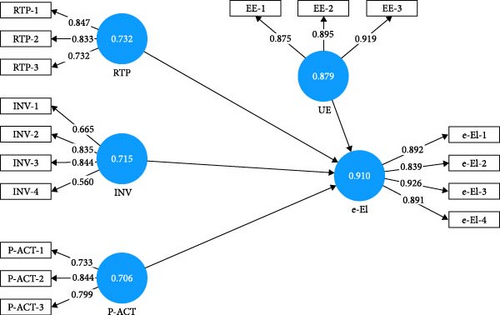
4.1.1. Reliability
Authors checked the two main indicators, Cronbach’s α and composite reliability, to evaluate the reliability of the constructs and found that the values of these indicators are above the minimum value (0.70) for each construct (Figure 5 and Table 5) [59].
| Composite reliability (ρ_a) | Composite reliability (ρ_c) | Cronbach’s α | Average variance extracted (AVE) | |
|---|---|---|---|---|
| UE | 0.89 | 0.925 | 0.879 | 0.804 |
| e-EI | 0.924 | 0.937 | 0.91 | 0.788 |
| INV | 0.773 | 0.821 | 0.715 | 0.542 |
| P-ACT | 0.721 | 0.835 | 0.706 | 0.629 |
| RTP | 0.753 | 0.847 | 0.732 | 0.649 |
- Source: Compiled by authors, based on SmartPLS analysis.
4.1.2. Convergent Validity
The average factor loadings and average variance extracted (AVE) of each construct are evaluated to establish the convergent validity. AVE of every construct is found greater than 0.5 which is its threshold limit. Factor loadings average for all the constructs is greater than 0.7. The convergence of each observed item with its respective construct is confirmed through these indicators [59].
4.1.3. Discriminant Validity
Heterotrait-Monotrait (HTMT) ratio (Table 6), Fornell and Larcker criterion, and cross-loading values are used to check the discriminant validity. These indicators helped the authors in establishing the discriminant validity of each construct. The maximum threshold limit of the HTMT ratio is 0.85 [51] or 0.90 [60]. The discriminant validity of the model is approved by the HTMT ratio as this ratio is far below for each construct than its maximum threshold limit (Table 6). Fornell and Larcker criterion also confirms the discriminant validity of the model by showing the square root of AVE. It is larger for its own construct than its correlation with other constructs, as required in Fornell and Larcker criterion. Cross-loading also establishes discriminant validity. The correlation of observed items with their respective latent variable is far higher than any other latent variable.
| UE | e-EI | INV | P-ACT | RTP | |
|---|---|---|---|---|---|
| UE | |||||
| e-EI | 0.242 | ||||
| INV | 0.25 | 0.359 | |||
| P-ACT | 0.176 | 0.391 | 0.678 | ||
| RTP | 0.043 | 0.364 | 0.369 | 0.181 |
- Source: Compiled by authors, based on SmartPLS analysis.
4.1.4. Model Fit Indices (SmartPLS 4.0) and PLS Predict
SRMR, d_G, d_ULS, χ2, and NFI are the main indices that are provided by SMARTPLS 4.0 as model fit indices. These indices are also met under their respective threshold limit (Table 7) for this study.
| Saturated model | Estimated model | Acceptable limit | |
|---|---|---|---|
| S R M R | 0.067 | 0.067 | Less than 0.08 |
| d_ULS | 0.682 | 0.682 | Less than 1 |
| d_G | 0.271 | 0.271 | Less than 1 |
| χ2 | 336.503 | 336.503 | Acceptable in SmartPLS |
| NFI | 0.89 | 0.89 | Not less than 0.9 |
- Source: Compiled by authors, based on SmartPLS analysis.
PLS predict, another model fit indicator, also supports the PLS model in comparison to the linear model, as the values of PLS-SEM_RMSE and PLS-SEM_MAE are lower than LM_RMSE and LM_MAE, respectively, except the values of PLS-SEM_MAE of EI-2 which is higher than LM_MAE value of EI-2 [61]. Q2 predict values are also found positive and in range (Table 8).
| Q2 predict | PLS-SEM_RMSE | PLS-SEM_MAE | LM_RMSE | LM_MAE | |
|---|---|---|---|---|---|
| EI-1 | 0.149 | 1.176 | 0.976 | 1.209 | 0.994 |
| EI-2 | 0.085 | 1.274 | 1.121 | 1.3 | 1.108 |
| EI-3 | 0.169 | 1.126 | 0.897 | 1.157 | 0.905 |
| EI-4 | 0.104 | 1.221 | 1.024 | 1.273 | 1.063 |
- Source: Compiled by authors, based on SmartPLS analysis. Bold value of PLS-SEM_MAE of EI-2 shows that it is lower than the value of LM_MAE of EI-2.
4.2. Hypotheses Testing
Two-stage path analysis is conducted to test the hypotheses proposed in this study. Hypotheses H1, H2, H3, and H4 are tested in the first phase. These hypotheses show the relation of IVs, i.e., RTP, INV, P-ACT, and UE, respectively, with e-EI (Figures 3 and 5 and Table 8). In the second stage, moderating effects of UE and gender are tested. Hypotheses H5a, H5b, and H5c are listed to show the moderating effect of UE, respectively, on the relationships of IVs like RTP, INV, and P-ACT with e-EI (Figures 3 and 5 and Table 9) while H6a, H6b, and H6c record the effect of gender moderation, respectively, on the relations of RTP, INV, and P-ACT with e-EI (Figures 3 and 5 and Table 10).
| Hypothesis | Standardized estimates | Sample mean (M) | Standard deviation (SD) | T statistics | P-values | |
|---|---|---|---|---|---|---|
| H1 | RTP ⟶ e-EI | 0.255 | 0.258 | 0.073 | 3.5 | 0 |
| H2 | INV ⟶ e-EI | 0.101 | 0.11 | 0.081 | 1.243 | 0.214 |
| H3 | P-ACT ⟶ e-EI | 0.219 | 0.223 | 0.074 | 2.967 | 0.003 |
| H4 | UE ⟶ e-EI | 0.168 | 0.17 | 0.066 | 2.537 | 0.011 |
| No. | Hypothesis | Original sample (O) | Sample mean (M) | Standard deviation (SD) | T statistics | P-values |
|---|---|---|---|---|---|---|
| H5a | UE × RTP ⟶ e-EI | −0.156 | −0.155 | 0.066 | 2.37 | 0.018 |
| H5b | UE × INV ⟶ e-EI | −0.017 | −0.019 | 0.078 | 0.216 | 0.829 |
| H5c | UE × P-ACT ⟶ e-EI | 0.231 | 0.232 | 0.083 | 2.797 | 0.005 |
| H6a | Gender × RTP ⟶ e-EI | −0.103 | −0.109 | 0.18 | 3.568 | 0.042 |
| H6b | Gender × INV ⟶ e-EI | −0.129 | −0.144 | 0.245 | 3.732 | 0.004 |
| H6c | Gender × PACT ⟶ e-EI | 0.222 | 0.246 | 0.251 | 0.2.967 | 0.05 |
4.2.1. Hypotheses Testing (H1, H2, H3, and H4)
β coefficients (standardized estimates) for all four hypotheses (H1, H2, H3, and H4) are positive and range from 0.255 (for RTP ⟶ e-EI) to 0.101 (for INV ⟶ e-EI). It provides a comparison of the strength of the effect of each IV on the DV. Thus, the greater the value of standardized estimates, the stronger the effect. So, RTP’s effect on the e-EI is the strongest, and INV’s effect on the e-EI is the weakest. T statistics values range from 3.5 (for RTP) to 1.243 (for INV).
Hence, the hypotheses H1, H3, and H4 which are supported by their respective positive standardized estimates, T statistics, and P-values, are accepted and the hypothesis H2, with its positive standardized estimates, is rejected because T statistics and P-value prove its path insignificant (Table 9).
4.2.2. Moderation Effect: Hypotheses, H5a, H5b, H5c, H6a, H6b, and H6c
Hypotheses H5 (H5a, H5b, and H5c) and H6 (H6a, H6b, and H6c) are tested, showing the moderation (interaction) effect of UE and gender, respectively, in two separate path analysis models
(1) Two-tailed test type: moderation effect of UE (H5a, H5b, and H5c). The authors opted for a two-tailed test type, a significance level of 5%, and a “bias-corrected and accelerated” (BCa) technique of confidence interval in the settings. With this set of settings, a bootstrapping technique (SmartPLS 4.0) is used at 5,000 subsamples to assess the moderating effect of UE [62].
Table 9 shows that hypotheses H5a (UE × RTP ⟶ e-EI) and H5b (UE × INV ⟶ e-EI) are rejected due to negative standardized estimates (β coefficients). It means RTP (β coefficient −0.156) and INV (β coefficient −0.017) both are negatively correlated with e-EI if moderated by UE. T statistics and the P-value of the path “UE ×RTP ⟶ e-EI” are under the range of 5% significance but it becomes irrelevant to discuss the significance level if the hypothesis is rejected based on the path coefficient (standardized estimates). T statistics (0.216) and P-value (0.829) of the path (UE × INV ⟶ e-EI) also reject its respective hypothesis.
Hypothesis H5c (UE × P-ACT ⟶ e-EI) is accepted with a positive standardized estimate (0.231) which shows that UE moderates this relationship positively as hypothesized in the underlying hypothesis. T statistics and the P-value of the path also support the 5% significance level of the path (Table 10)
(2) One-tailed test type: moderation effect of gender (a categorical moderator) (H6a, H6b, and H6c). The moderating effect of GEN was evaluated separately from the moderating effect of UE in SmartPLS 4.0. Authors used different settings to measure the moderating effect of gender because of its categorical nature. Instead of using standardized product terms and two-tailed test types, it is advised to use unstandardized product terms and one-tail test types in the advanced settings for a categorical variable like GEN [63].
Standardized estimates of the paths “GEN × RTP ⟶ e-EI” and “GEN × INV ⟶ e-EI” are negative (−0.103 and −0.129, respectively) which proves that GEN negatively moderates the relation of RTP and INV with e-EI. Hence, H6a and H6b hypotheses are accepted (Figures 6 and 7). Hypothesis H6c is rejected because of the positive standardized estimate (0.222) of its path that shows the positive moderating effect of GEN on the relations of P-ACT with e-EI (Figure 8). As far as the significance of the path is concerned, all three paths H5a, H5b, and H5c are found significant at a 5% significance level but the discussion over the path of H5c became irrelevant because of its rejection based on its standardized estimate [64].
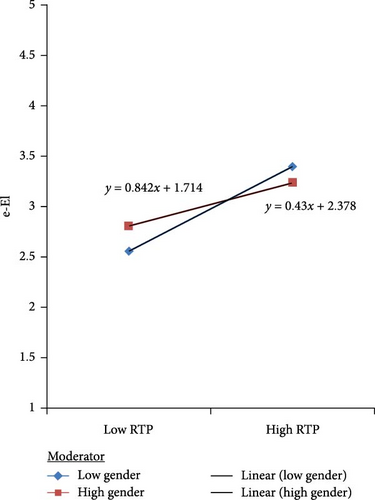
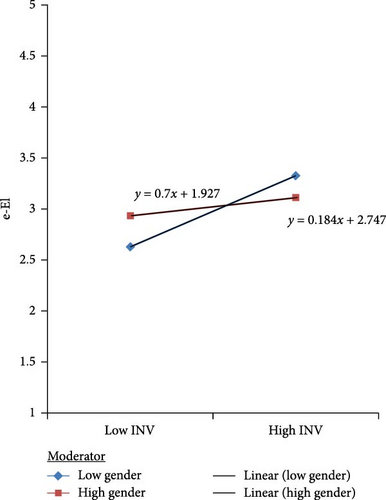
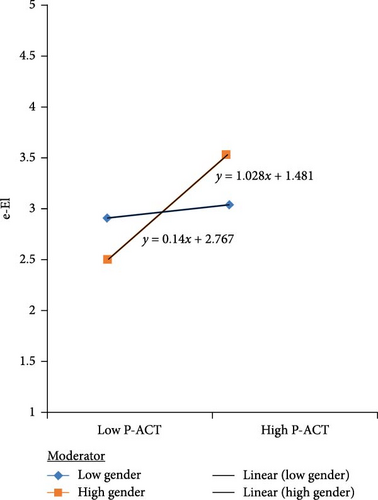
5. Discussion and Conclusion
Saudi Arabia has already recognized the importance of entrepreneurship and allocated a lot of resources in Vision 2030 to enhance the level of entrepreneurial activities, especially among the students. The investment in the educational infrastructure under Vision 2030 is significant and the government is targeting to promote entrepreneurial intention among the students at school as well as university level [65]. Apart from that, there are many government funded public and private institutions also to help budding entrepreneurs. Global entrepreneurship monitor also discussed the result of these initiatives in its country-specific report on Saudi Arabia for the year 2020–2021 [66, 67]. This report reveals that more than 90% of Saudi adults consider entrepreneurship as a good choice of career in the long-term because entrepreneurship brings social status, positive attention from the media, and recognition [68]. They also agreed that it is easy to establish a new venture in the country. This is the highest percentage among the Middle East and African (MENA) countries [69]. On the other hand, approximately half (49%) of respondents who got the opportunities to act, accepted that they would not go for those opportunities due to the fear of getting failed. The report further stated that 33% of Saudi adults have the entrepreneurial intention to start their business in the next 3 years. And in the response to a question from the survey conducted for this study, 77% of students show their intention to start an e-venture if they get the opportunity after completing their studies and only 20% want to be a traditional entrepreneur while 3% did not opt for this question [70]. Between males and females, 77% of the total male students show their intention to be an e-entrepreneur while only 73% of female students opt for the option of becoming an e-entrepreneur. E-entrepreneurship is an emerging field, and it is getting special attention from the government in Vision 2030 [71]. Government is committed and has a target to increase the contribution of the digital economy to the GDP by up to 19.6% of GDP by 2030 [72].
This study also extends the discussion from entrepreneurial intention to e-EI and found some very interesting results during the evaluation of hypotheses, like, it found that student innovativeness is not corelated with their e-EI [73, 74]. It means the increasing level of innovativeness of students does not necessarily increase their e-EI. While in the case of traditional entrepreneurship, many studies have revealed that INV is highly correlated with entrepreneurial intention [75]. That means people with high innovativeness will also have a high level of entrepreneurial intention. Apart from that, the rest of the variables RTP, UE, and P-ACT are positively correlated with the e-EI of the students.
This study also reveals a few interesting facts in the moderation analysis. The authors used two moderating variables UE and GEN. Using UE as moderating variable, they found that the current level of UE enhances (positive moderation) the relationship of P-ACT with e-EI but weakens the relationship of RTP with e-EI, and it is insignificant in the case of INV with e-EI. The authors explored the moderating role of GEN to discover the impact of RTP, INV, and P-ACT on students on their e-EI. Gender moderation in the study provided the mix results. On the one hand, the relationships of RTP and INV with e-EI for female students are observed weaker by 10.3% and 12.9%, respectively, in comparison to male students. On the other hand, the relationship of P-ACT with e-EI for female students is stronger by 22.2% in comparison to the male student [76]. The authors interpreted that the RTP and innovativeness of female students are weaker than male students because they are less exposed to the industry/market and have a very limited interest in these activities. Ultimately that reduces the level of their overall entrepreneurial intention and, hence, also e-EI.
6. The Implication of the Study and the Authors’ Recommendations
6.1. Implications
Theoretical implications: This study reveals that (1) the innovativeness of the students does not have any significant effect on their e-EI. (2) The study further confirms that UE does not strengthen the relationship between the RTP of the students (UE × RTP ⟶ e-EI; H5a) and the relationship of their innovativeness (UE × INV ⟶ e-EI; H5b) with their e-EI to start an e-business. (4) Another important fact that is disclosed by this research is female students’ e-EIs which are not as much as males’ e-EIs. All these facts imply that there is a lack of entrepreneurial content in the UE curriculum as well as a lack of entrepreneurial activities on university campuses. It further implies that female students are less exposed to industrial exposure, and they do not have enough entrepreneurial intention in comparison to male students.
Practical implications: The current research work will surely be considered valuable for many groups/institutions/individuals from the different fields of academics, policy-making, and entrepreneurial practices along with decision-making in the Saudi Vision 2030. It is also implied from this study that the university stakeholders will consider the theoretical implications of this study before reaching any decision or conclusion to promote entrepreneurial activities on campus.
Developing a business incubator will turn things in favor of budding entrepreneurs and it will provide entrepreneurial exposure to all the students.
6.2. Recommendations
- (a)
Providing consultation/legal advice to budding entrepreneurs and helping them in registering new ventures
- (b)
Providing coworking space to newly registered businesses for at least 1 year (for students and recent alumni)
- (c)
Getting university’s MoU/agreements with the government or funded agencies to promote entrepreneurship
- (d)
Increasing networking with the successful alumni entrepreneurs
- (e)
Conducting events of pitching the idea or products in front of investors/venture capitalists
- (f)
Scheduling motivational programs/lectures of external experts/entrepreneurs
- (g)
Increasing the number of entrepreneurial competitions/quizzes and the number of entrepreneurship certificate programs
7. Limitations and Scope for Future Researches
The data for this study are collected from the students of different campuses of SEU. Although SEU is a big university with more than 10 campuses and thousands of students from all corners of the country but collecting the data only from one university might be considered a limitation of the study.
Instead of limiting the scope of future research, this limitation opens-up the new areas for future research which can include a sample size from multiple universities and from different disciplines. The future researcher may also extend the comparative studies based on disciplines, universities, or countries with a relatively big dataset.
To make the study very precise and focused, the authors took only four variables into consideration. This fact is both the strength and limitation of the study at the same time. Future researchers have the chance to bring more cognitive variables on board to study and link them with e-EI. Using cross-sectional data may also be considered a limitation here. Because, under this type of dataset, each respondent fills the responses only once and at a particular time which may further create the difference in the actual and estimated entrepreneurial behavior of the students. It is suggested to future researchers, use a longitudinal dataset for such types of studies.
Conflicts of Interest
The authors declare that they have no conflicts of interest.
Funding
The authors extend their appreciation to the Deputyship for Research & Innovation, Ministry of Education, Saudi Arabia, for funding this research work through the project number 7945. The authors are also grateful to the Deputyship for Research & Innovation, Ministry of Education, Saudi Arabia for the funding of the article processing charges.
Acknowledgments
The authors appreciate and are thankful to the Research Ethics Committee for approving (REC Number: SEUREC-22010) this study on 2/3/2022. We are also thankful to the participants for sparing time to fill out the questionnaire and express our gratitude to the colleagues, reviewers, editor, and the team publishing house for helping us to improve this study further.
Appendix 1
See Figure 9 (adapted from [77]).
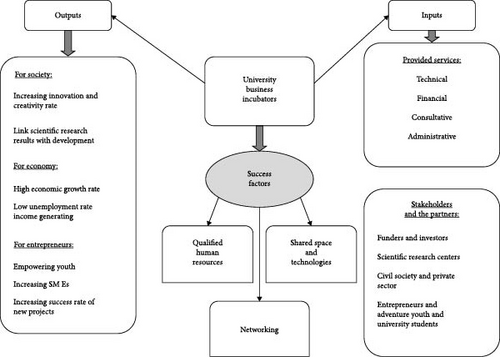
Open Research
Data Availability
The data used to support the findings of this study are available from the corresponding author upon request.




